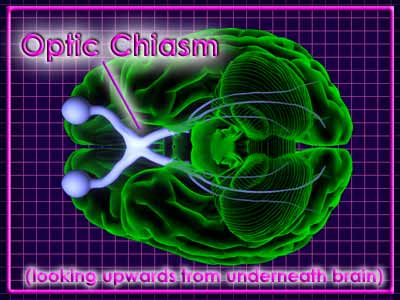“Anatomy,”
he says.
“Anatomy is the answer.
You could carefully remove the brain of the wild dog
you just ran over with your chariot and try to follow the pathways from the eyes into the brain.
If you can find what’s connected to what, it
will give you an idea of the possible function of a particular part of the brain.”
Up goes your hand.
Mindstein nods in your direction.
“But wouldn’t the dog’s brain just
be mush?”
you ask, remembering your own efforts with a recently
killed squirrel you found in the street in front of your house.
Mindstein looks surprised.
“That’s right,” he admits, “but
my point’s still valid.
For a long time, all the early brain researchers
could do was describe the external anatomy of the brain.
They named parts they could see, often based on
their appearance, and that was about it.
They could see, for example, that the optic nerves
from the eyes come together under the base of the brain to form a structure that looks a lot like the letter ‘X,’
or ‘chi’ (pronounced ‘kI,’ long ‘I’), so they inferred that the optic chiasm has something
to do with vision.”
 | “This conclusion was correct: the optic chiasm routes neurons from the eye
to the correct areas of the brain.
Even though the Greeks made some valid discoveries
about the brain, we have learned much about how the brain is put together since the days of the Greeks, and that’s what
I’m going to tell you about–the anatomy of the nervous system, or neuroanatomy.”
|
